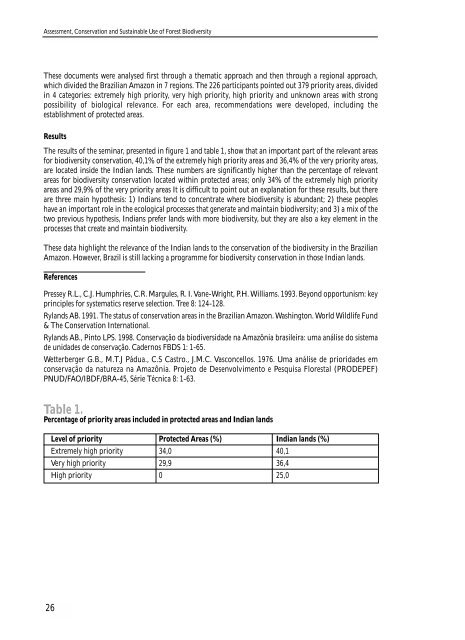Assessment, Conservation and Sustainable Use of Forest Biodiversity
Assessment, Conservation and Sustainable Use of Forest Biodiversity
Assessment, Conservation and Sustainable Use of Forest Biodiversity
Create successful ePaper yourself
Turn your PDF publications into a flip-book with our unique Google optimized e-Paper software.
<strong>Assessment</strong>, <strong>Conservation</strong> <strong>and</strong> <strong>Sustainable</strong> <strong>Use</strong> <strong>of</strong> <strong>Forest</strong> <strong>Biodiversity</strong><br />
These documents were analysed first through a thematic approach <strong>and</strong> then through a regional approach,<br />
which divided the Brazilian Amazon in 7 regions. The 226 participants pointed out 379 priority areas, divided<br />
in 4 categories: extremely high priority, very high priority, high priority <strong>and</strong> unknown areas with strong<br />
possibility <strong>of</strong> biological relevance. For each area, recommendations were developed, including the<br />
establishment <strong>of</strong> protected areas.<br />
Results<br />
The results <strong>of</strong> the seminar, presented in figure 1 <strong>and</strong> table 1, show that an important part <strong>of</strong> the relevant areas<br />
for biodiversity conservation, 40,1% <strong>of</strong> the extremely high priority areas <strong>and</strong> 36,4% <strong>of</strong> the very priority areas,<br />
are located inside the Indian l<strong>and</strong>s. These numbers are significantly higher than the percentage <strong>of</strong> relevant<br />
areas for biodiversity conservation located within protected areas; only 34% <strong>of</strong> the extremely high priority<br />
areas <strong>and</strong> 29,9% <strong>of</strong> the very priority areas It is difficult to point out an explanation for these results, but there<br />
are three main hypothesis: 1) Indians tend to concentrate where biodiversity is abundant; 2) these peoples<br />
have an important role in the ecological processes that generate <strong>and</strong> maintain biodiversity; <strong>and</strong> 3) a mix <strong>of</strong> the<br />
two previous hypothesis, Indians prefer l<strong>and</strong>s with more biodiversity, but they are also a key element in the<br />
processes that create <strong>and</strong> maintain biodiversity.<br />
These data highlight the relevance <strong>of</strong> the Indian l<strong>and</strong>s to the conservation <strong>of</strong> the biodiversity in the Brazilian<br />
Amazon. However, Brazil is still lacking a programme for biodiversity conservation in those Indian l<strong>and</strong>s.<br />
References<br />
Pressey R.L., C.J. Humphries, C.R. Margules, R. I. Vane-Wright, P.H. Williams. 1993. Beyond opportunism: key<br />
principles for systematics reserve selection. Tree 8: 124-128.<br />
Ryl<strong>and</strong>s AB. 1991. The status <strong>of</strong> conservation areas in the Brazilian Amazon. Washington. World Wildlife Fund<br />
& The <strong>Conservation</strong> International.<br />
Ryl<strong>and</strong>s AB., Pinto LPS. 1998. Conservação da biodiversidade na Amazônia brasileira: uma análise do sistema<br />
de unidades de conservação. Cadernos FBDS 1: 1-65.<br />
Wetterberger G.B., M.T.J Pádua., C.S Castro., J.M.C. Vasconcellos. 1976. Uma análise de prioridades em<br />
conservação da natureza na Amazônia. Projeto de Desenvolvimento e Pesquisa Florestal (PRODEPEF)<br />
PNUD/FAO/IBDF/BRA-45, Série Técnica 8: 1-63.<br />
Table 1.<br />
Percentage <strong>of</strong> priority areas included in protected areas <strong>and</strong> Indian l<strong>and</strong>s<br />
Level <strong>of</strong> priority Protected Areas (%) Indian l<strong>and</strong>s (%)<br />
Extremely high priority 34,0 40,1<br />
Very high priority 29,9 36,4<br />
High priority 0 25,0<br />
26

















